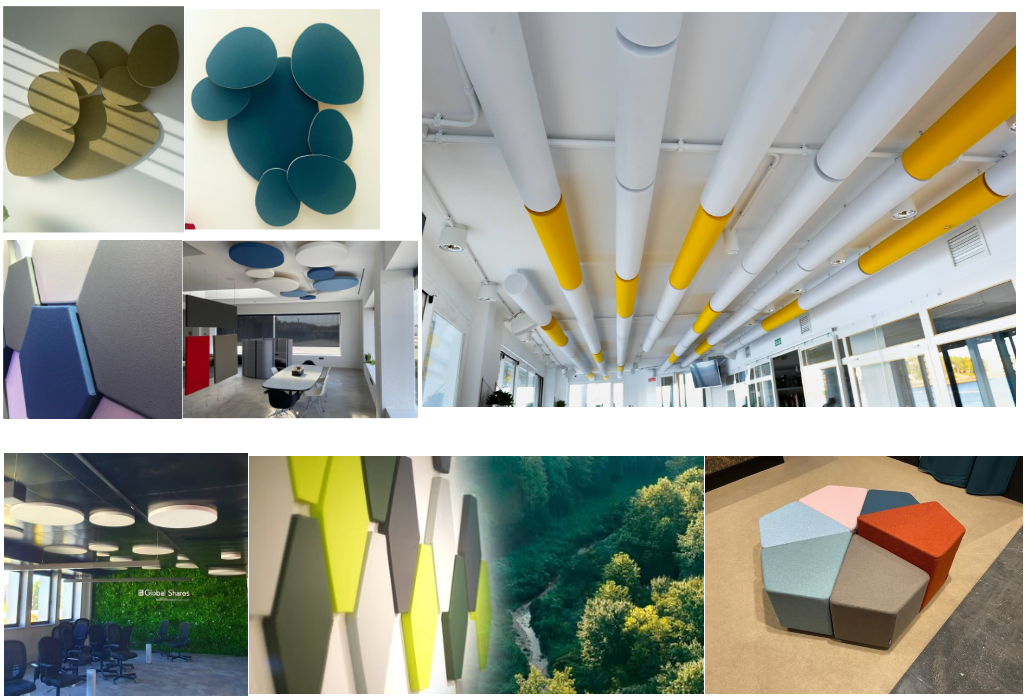SOUND ABSORPTION | ARCHITECTURAL ACOUSTICS
Sound Absorption: What It Is and How It Works
Sound absorption is the ability of a material to absorb sound waves that strike its surface, thereby reducing reverberation and noise within a space. Sound-absorbing materials capture sound and convert it into heat, reducing its transmission to other areas of the environment. The more porous and dense the material, the more effectively it can absorb sound.
Sound absorption is critical in spaces where sound quality is essential – from recording studios and concert halls to office spaces and residential areas seeking improved acoustic comfort.
Sound Absorption vs. Soundproofing: What Are the Differences?
Many confuse sound absorption with soundproofing, but they are two distinct concepts:
- Sound Absorption: Focuses on reducing sound reflections within the same space. Sound absorption techniques involve using materials that absorb sound, resulting in a reduction of Reverberation Time and annoying noises. For example, foam materials or sound-absorbing panels absorb sound before it reflects back into the room.
- Soundproofing: Aims to limit the transmission of sound from one space to another. Soundproofing uses dense, high-mass materials that block sound transmission through walls, floors, or ceilings.
In short, sound absorption improves the acoustic quality inside a space, while soundproofing focuses on preventing noise from passing through the space.
Stop Sound Constructions’ sound absorption solutions stand out for their high quality and effectiveness, as they consist of Laboratory-Certified Acoustic products rather than mere decorative elements.
This distinction makes them unique on the market, as each product features certified sound absorption with an absorption coefficient (αw) ranging from 0.5 to 1.0, ensuring excellent sound absorption performance.
Moreover, all products comply with the strictest fire resistance standards BS1d0, ensuring not only acoustic comfort but also safety in the spaces where they are applied.

Representative Solutions of Laboratory-Certified Sound Absorption by Stop Sound Constructions
Sound Absorption Solutions: Materials and Applications
The choice of suitable materials for sound absorption depends on the specific needs of each space:

Sound Absorption in Architecture: A Strategic Design Factor
Sound absorption is not just a technical necessity – it is also a vital element of architectural design. Its integration can transform a space, providing quality sound and quietness.
- Strategic Design: By placing sound-absorbing materials in appropriate locations (such as walls, ceilings, or floors) within a space, we can reduce reverberation and improve sound quality without compromising the space’s aesthetics.
- Integrated Approach: Architects, in collaboration with Stop Sound Constructions and specialized acoustic engineers & consultants, achieve the best possible combination of sound absorption and architectural aesthetics.
- Layout and Usability: Especially in public spaces such as auditoriums, libraries, or restaurants, proper arrangement of sound-absorbing materials is critical to ensure that reflected noise does not cause disturbances or degrade the acoustic experience.
Acoustic Study
The Acoustic Study is a fundamental step for the effective implementation of sound absorption solutions in indoor environments. This process always begins with an extensive evaluation of the space to understand its particular needs and conditions. Before selecting or installing any material or technique, the study includes the following stages:
- Evaluation of Acoustic Characteristics: This stage precisely examines the acoustic parameters of the space. The sound diffusion, reverberation time, sound frequency, and general noise level are analyzed. These data are crucial for understanding how sound interacts with the environment and what the requirements for soundproofing and sound absorption are.
- Strategic Application of Materials and Devices: Based on the analysis results, the most appropriate materials and techniques are selected to ensure efficient sound absorption. Each material is strategically placed in the space to maximize effectiveness, considering the unique needs of each environment.
- Acoustic Adjustment and Design Optimization: If necessary, the study may include modifications to the original space design. These changes ensure that sound absorption techniques work at their highest potential, eliminating reverberation problems and other acoustic imperfections that may limit the room’s performance.
Stop Sound Constructions specializes in creating and implementing acoustic solutions that combine expertise with aesthetics. With a carefully structured approach, we design spaces that offer exceptional acoustic comfort and quality, eliminating unwanted noise. Whether for residential, commercial, or public spaces, our team provides comprehensive acoustic solutions tailored to each client’s needs. Our goal is to create environments that enhance sound absorption, ensuring absolute acoustic comfort and improved sound quality in every space.


